The term “Technology Trends” describes the most recent innovations and strides made in the technology sector. These trends, which are the outcome of ongoing research, invention, and acceptance of new technology, have a big impact on many different industries and our daily lives.
Table of Contents
Some common technology trends that were prevalent around that time included:
1. Artificial Intelligence (AI) and Machine Learning (ML)
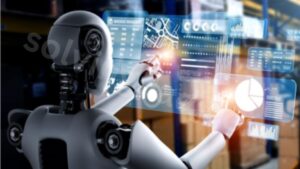
Within the broader field of computer science and data science, artificial intelligence (AI) and machine learning (ML) are closely linked disciplines. They entail the creation of algorithms and systems that allow computers to imitate human intelligence and learn from data to do certain activities more effectively. ML is a particular subset and application of AI, whereas AI is a more general term.
- Artificial intelligence (AI) is the emulation of human intellect in computers, enabling them to carry out operations that ordinarily call for human intelligence, such as reasoning, problem-solving, perception, learning, planning, and language understanding. Building machines that behave intelligently, comprehend their surroundings, and adapt to changing conditions in order to accomplish certain goals is the aim of artificial intelligence (AI). There are two broad categories in which AI can be placed:
- Narrow AI, also known as weak AI, is created and educated to carry out a single task or a limited range of tasks. Examples include picture recognition software, virtual assistants like Siri and Alexa, and streaming services’ usage of recommendation algorithms.
- General AI (Strong AI) is a hypothetical type of AI that, like a person, would be able to comprehend, pick up knowledge, and apply it to a variety of jobs. The development of general AI is still a long way off.
- Machine Learning (ML) is a branch of artificial intelligence that focuses on creating statistical models and algorithms that let computers learn from data and make predictions or judgments without having to be explicitly programmed for each task. Pattern- and trend-spotting ML systems can spot trends and can get better with practice and exposure to more data.
Machine Learning can be categorized into different types:
- In this method of learning, input-output pairs are given to the model, and the algorithm is trained using labeled data. The system can predict outcomes based on fresh, unforeseen data after learning to map inputs to outputs.
- Unsupervised learning: The algorithm is tasked with identifying patterns or structures in the unlabeled data. Finding significant insights from the data is its goal; it does not get specific output labels.
- The algorithm learns by interaction with the environment in reinforcement learning. It is guided to learn the best behavior to accomplish a certain objective by feedback in the form of rewards or penalties.
Numerous fields have benefited from the use of machine learning, including image and audio recognition, natural language processing, recommendation systems, medical diagnosis, financial forecasting, and more.
2. Edge Computing
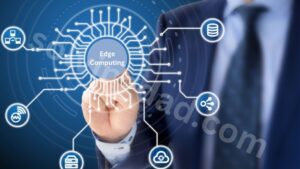
Edge computing is a decentralized computing strategy that relies on local data centers or cloud services in addition to bringing computation and data storage closer to the point of demand, which is often close to the edge of the network. The primary idea behind edge computing is to process data locally on edge devices or edge servers and carry out computations, obviating the need to transport all data to a central location for processing.
For processing, analysis, and storage, classical cloud computing sends data from gadgets or sensors to a distant data center or cloud server. However, this centralized method might result in problems like network latency, capacity restrictions, and higher data transmission costs due to the growing amount of data created by Internet of Things (IoT) devices and other linked systems.
These problems are solved by edge computing, which brings some data processing and analysis duties closer to the data source. In other words, data is processed on or very near the edge devices themselves, or on nearby local servers. Edge computing benefits from this in a number of ways:
- Reduced Latency: Because there is no need to send data back and forth to a centralized server, processing data locally speeds up the process of receiving results. This is crucial for applications like industrial automation and driverless cars that require real-time or almost real-time reactions.
- Bandwidth optimization: By reducing the amount of data that must be transferred to the cloud, edge computing optimizes bandwidth use and relieves network congestion.
- Greater Reliability: Local processing makes certain that crucial processes can still be carried out even in the event of network connectivity problems or disruptions.
- Enhanced privacy and security: By processing and storing sensitive data locally instead of sending it to a central data center, edge computing reduces the chance of sensitive information being compromised.
- Scalability: Edge computing allows for the efficient and scalable processing of massive volumes of data by distributing computational workloads among several edge devices.
In situations like industrial IoT, smart cities, autonomous vehicles, remote monitoring, and several other applications where real-time or low-latency data processing is crucial, edge computing is very beneficial. It supports cloud computing, which is still crucial for jobs that call for a lot of data storage, analysis, and long-term archiving.
The “edge-to-cloud” continuum, which combines edge computing and cloud computing, enables businesses to create comprehensive and effective computing infrastructures that can handle the many requirements of contemporary applications and services.
3. Virtual Reality (VR) and Augmented Reality (AR)

Virtual reality (VR) and augmented reality (AR) are immersive technologies that change how we perceive the real world while also producing interactive, interesting, and fun experiences. Despite having certain commonalities, they differ in their application and the degree of immersion they offer.
- Virtual Reality (VR) is a technique that submerges people in a 3D computer-generated virtual world while simulating an entirely fake environment. In order to experience VR, users often wear specialized headsets or goggles that obstruct their vision of the outside world in favor of a virtual one. Users can interact and explore this virtual environment as if they were actually there.
Key characteristics of Virtual Reality include:
- Immersive Experience: VR gives people the impression that they are physically present in the virtual world. Head tracking, 3D visuals, and spatial audio are used to accomplish this.
- Full Control: Through motion controllers or other input devices, users can frequently engage with the VR environment, manipulating items and moving around in the virtual world.
- Applications: VR has uses in entertainment, education, healthcare, training and simulations, architectural visualisation, and gaming.
- Through the use of digital content that is superimposed on the physical world, augmented reality (AR) allows users to perceive reality more vividly. Contrary to virtual reality (VR), which completely replaces the real environment, augmented reality (AR) frequently makes use of smartphones, tablets, or AR glasses to add computer-generated information to it.
Key characteristics of Augmented Reality include:
- Real-World Overlay: AR enhances a user’s perception of the outside world by overlaying digital items like pictures, text, or 3D models. The real-world environment is captured and shown with pertinent digital content via cameras and sensors.
- Users can interact with digital content in AR that is frequently contextually relevant to the real world. With the use of digital overlays, augmented reality (AR) enables users to acquire information, visualise data, and carry out tasks.
- Applications: Augmented reality (AR) has a wide range of uses, including gaming (such as Pokémon GO), navigation, marketing, remote help, industrial training, and educational activities.
Differences between VR and AR:
The levels of immersion and interactions between VR and AR and the actual world are where the main differences between the two technologies lie:
- With virtual reality, the physical world is completely replaced with a virtual setting, creating an incredibly immersive experience.
- VR offers a completely immersive experience by completely replacing the real world with a virtual one.
There are many intriguing applications for VR and AR, and as technology develops, we may anticipate even more creative and useful uses for these immersive mediums.
4. Robotic Process Automation (RPA)

Robotic process automation (RPA) is a technology that automates routine and rule-based operations within corporate processes using software robots or “bots.” These bots carry out activities just as a human operator would, simulating human interactions with computer systems, applications, and data sources. In a variety of businesses and organisations, RPA is frequently used to improve operational effectiveness, eliminate human error, and streamline workflows.
Key characteristics and aspects of Robotic Process Automation include:
- Rule-Based Automation: To complete particular tasks, RPA bots adhere to specified rules and instructions. They are not intended to make decisions on their own, but rather to carry out planned logic-based behaviours.
- User Interface Interaction: RPA bots interact with user interfaces in the same way that a human user would. They are capable of utilising software systems to navigate through applications, input data, extract information, and complete other operations.
- Non-Invasive Technology: RPA does not call for extensive IT infrastructure alterations or complex integrations. It is a non-intrusive automation solution that runs as a layer on top of current systems and applications.
- Scalability and Replicability: Organisations can simply deploy RPA bots across numerous machines and extend automation across a variety of processes and departments thanks to the ease with which they can be duplicated.
- Savings in time and money: RPA makes repetitious processes easier to accomplish by automating them. Increased productivity and considerable cost reductions can result from this.
- Error Reduction: RPA reduces the possibility of human errors that may happen during repetitive manual activities, improving accuracy and data quality.
- Automation in the Back-Office and Front-Office: RPA can be used for both back-office operations like data entry and data reconciliation and front-office tasks like order processing and customer care.
Data entry, invoice processing, report generating, payroll management, customer service, and other repetitive administrative duties are a few examples of operations that can be implemented with RPA.
It’s crucial to understand how RPA differs from machine learning and artificial intelligence (AI). RPA is restricted to following rules and lacks the ability to make judgements, whereas AI and ML concentrate on teaching algorithms to draw conclusions from data and make wise choices. However, RPA and AI can work together as complimentary technologies, and RPA can occasionally work with AI-driven systems to accomplish jobs more quickly.
RPA has become increasingly popular in recent years as businesses look for ways to automate repetitive operations, boost productivity, and free up staff for higher-value duties. RPA is anticipated to keep playing a significant part in attempts to implement digital transformation across industries as technology develops.
5. Quantum Computing
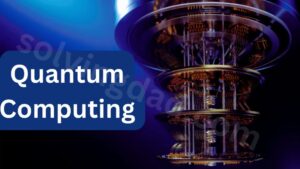
The concepts of quantum physics are used to conduct computations in quantum computing, a sophisticated computing paradigm. Quantum computers use quantum bits, also known as qubits, which can exist in numerous states at once due to the phenomena of superposition and entanglement. In contrast to classical computers, which use bits (binary digits) to encode data as 0s and 1s, qubits can exist in multiple states concurrently.
Key principles of quantum computing include:
- Superposition: Qubits can concurrently represent a 0, a 1, or any combination of 0 and 1. This is known as superposition. Due to this characteristic, quantum computers are able to carry out several calculations simultaneously.
- Entanglement: Qubits are capable of being entangled, which implies that even when they are physically separated, the state of one qubit affects the state of another. Strong correlations between qubits are made possible by entanglement, which also makes some calculations on quantum computers more effective.
- Quantum Gates: Quantum computing manipulates qubits using quantum gates, which are comparable to the classical logic gates used in conventional computing. Quantum computations are made possible via quantum gates, which carry out operations that change the qubits’ quantum states.
There are considerable potential benefits of quantum computing over traditional computing, particularly for particular kinds of problems. Quantum computers may be able to complete some complicated tasks significantly more quickly than conventional computers. Several issues where quantum computing can flourish include:
- Large Number Factoring: Large numbers are computationally difficult for conventional computers to factor, but quantum methods, like Shor’s algorithm, can do it quickly. This has repercussions for cryptography and the decryption of several encryption techniques employed in traditional computers.
- Problems with optimisation: Quantum computing can provide more effective solutions for problems with optimisation, such as selecting the best option from a huge pool of options, which is important in industries like supply chain management, finance, and transportation.
- Quantum Simulation: Insights into molecular interactions, materials, and chemical reactions can be gained by quantum simulation, which is a capability of quantum computers that is superior to that of classical computers.
However, quantum computing is still in its infancy, and a number of issues must be resolved before it can be used widely. Qubit coherence maintenance (quantum information is particularly susceptible to external noise), error correction, scaling the number of qubits, and developing dependable quantum hardware are some of these difficulties.
The creation of quantum computing technologies and algorithms is a top priority for researchers and businesses. It is crucial to control expectations and recognise that practical and widespread quantum computing applications might still be a few years or decades away, even if quantum computing has immense promise for revolutionising a variety of industries.
6. Blockchain

Blockchain is a distributed, decentralised digital ledger technology that makes it possible to store and transfer data in an unalterable, transparent, and safe manner. It attracted a lot of attention because it is the core technology powering Bitcoin, the first and best-known cryptocurrency. Its potential uses go far beyond cryptocurrencies, though.
Key characteristics of blockchain technology include:
- Decentralisation: In a blockchain, data is spread over a network of computers (nodes) rather than being held on a single central server. There is no single point of failure because each node has a copy of the whole blockchain.
- Transparency: The blockchain is a public ledger that is open to the public, making it possible for anybody to observe the information and transactions stored there. Participants’ real names are frequently used as pseudonyms, though.
- Immutability: Data on the blockchain cannot be changed or removed once it has been stored there. The chain of records is chronological and unbroken because each new block in the chain has a reference to the block before it.
- Consensus Mechanism: Members of the network must concur that transactions were legitimate in order to validate and add new blocks to the blockchain. To reach consensus and protect the network, many consensus algorithms are utilised, such as Proof of Work (PoW) or Proof of Stake (PoS).
- Smart Contracts: Ethereum and other blockchain technologies allow the execution of smart contracts. These are self-executing contracts with predetermined conditions that come into effect once the circumstances are satisfied.
Applications of blockchain technology include:
- Cryptocurrencies: As was already said, cryptocurrencies are digital assets that make use of blockchain technology to allow safe and decentralized transactions without the use of middlemen like banks.
- Supply Chain Management: Blockchain can increase supply chain transparency by tracking each stage of a product’s life cycle, from manufacturing to distribution, ensuring authenticity and minimizing fraud.
- Healthcare: Medical records can be made more safe and private with the use of blockchain, which also gives patients greater control over their data and allows for secure data interchange between healthcare providers.
- Voting Systems: By providing transparent and tamper-proof records, blockchain-based voting systems can improve the integrity of elections.
- Intellectual Property Protection: By using a blockchain to authenticate and timestamp digital content like music, art, and documents, plagiarism and copyright infringement are less likely to occur.
- Finance and payments: Blockchain has the potential to completely transform the financial sector by making cross-border transfers and remittances faster, more secure, and more affordable.
- Decentralized Applications (DApps): On blockchain systems like Ethereum, developers can create decentralized applications that use smart contracts to automate processes without the need for centralized middlemen.
While blockchain technology has many advantages, it also has drawbacks, such as scalability issues, energy requirements (for PoW-based blockchains), and regulatory issues. It is anticipated that as the technology develops, it will find more widespread uses across numerous industries and completely alter how data is exchanged, stored, and verified in the digital age.
7. Internet of Things (IoT)
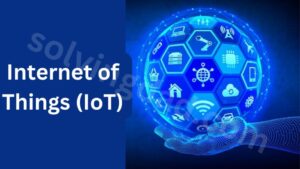
The term “Internet of Things” (IoT) refers to the concept of connecting commonplace physical things and gadgets to the Internet so they can exchange and collect data. These things, often known as “smart devices” or “connected devices,” might be anything from wearable tech to household appliances to vehicles to industrial machinery. IoT’s main goal is to make it possible for these things to interact with one another, analyse data, and take actions based on that information completely independently of human interaction.
Key components and characteristics of the Internet of Things include:
- Connectivity: IoT devices are connected to the internet and other devices in the same network thanks to sensors and communication technologies (such Wi-Fi, Bluetooth, cellular, or Low-Power Wide-Area Networks).
- Data Gathering: IoT devices use sensors to continuously gather data about their surroundings. These sensors are capable of measuring a wide range of variables, including temperature, humidity, motion, light, and more.
- Data analysis: To do the analysis, the gathered data is transferred to cloud-based platforms or edge computing systems. AI and data analytics tools are frequently used to process data, extract insightful information, and make decision based on data.
- Interoperability: The ability of various IoT systems and devices to operate in unison is essential for building an integrated and coherent IoT ecosystem.
- Automation: The Internet of Things (IoT) makes it possible for objects to autonomously respond to certain circumstances or triggers, carry out actions, and modify their behaviour in response to the data they receive.
- Enhanced Efficiency: IoT applications have the potential to improve efficiency and productivity across a range of industries, including transportation, healthcare, agriculture, and smart cities.
Examples of IoT applications in different domains:
- Smart Home: The Internet of Things (IoT) enables smart homes in which linked gadgets such as voice assistants, smart thermostats, smart lighting, and smart security cameras may be remotely managed through smartphone apps or voice commands.
- Industrial IoT (IIoT): IoT is utilised in the manufacturing, logistics, and asset tracking sectors of the economy for real-time monitoring, preventative maintenance, and process optimisation.
- Healthcare: IoT gadgets like remote patient monitoring systems and wearable fitness trackers assist in tracking vital indicators, keeping tabs on patient status, and delivering timely medical interventions.
- Smart Agriculture: IoT-based sensors and actuators in agriculture assist in monitoring soil moisture, temperature, and humidity, allowing farmers to optimise irrigation and increase crop yields.
- Connected Cars: IoT enables connected cars with integrated sensors and internet access, offering capabilities like GPS navigation, remote diagnostics, and vehicle-to-vehicle communication.
IoT has a lot of advantages, but it also has issues with standardisation, security, privacy, and data management. For IoT technologies to be adopted successfully and securely across many industries, it is essential to address these difficulties. IoT is anticipated to have a significant impact on how we connect with our surrounds and how organisations run in the digital age as it continues to develop.
8. Cybersecurity

Cybersecurity is the practise of defending computer systems, networks, data, and other digital assets from unauthorised access, attacks, damage, or theft. It is sometimes referred to as computer security or information security. In the modern era, where technology permeates nearly every part of our lives, including business, communication, banking, healthcare, and government, it is an essential field.
The main objectives of cybersecurity are to:
- Protect Confidentiality: Making sure that private information is kept private and that only authorised people or organisations can access it.
- Maintain Integrity: Ensure that data is accurate and reliable, and stop unauthorised alterations or tampering.
- Maintain Availability: Ensuring that networks, computers, and data remain reachable and accessible by authorised users at all times, avoiding disruptions or downtime.
- Protect Privacy: Ensuring that a person’s personal information is kept private and guarding against its misuse or unauthorised access.
Cybersecurity makes use of a range of instruments, methods, and best practises to protect digital assets and counteract online threats. Among the crucial elements of cybersecurity are:
- Firewalls: By regulating incoming and outgoing network traffic in accordance with preset security standards, firewalls serve as a barrier between a trusted internal network and the unreliable outside internet.
- Antivirus and Antimalware: Antivirus and antimalware software programmes are used to identify and eliminate malware, such as viruses, worms, trojan horses, and ransomware, from computer systems.
- Encryption: Data is encoded using encryption to make it unintelligible to anyone who lacks the necessary decryption key. When storing and transmitting sensitive information, it is utilised to protect it.
- Intrusion Detection and Prevention Systems (IDS/IPS): While IPS can automatically take actions to block or prevent possible attacks, IDS examines network traffic for suspicious activities.
- Multi-Factor Authentication (MFA): MFA adds an additional layer of security by requiring users to present several forms of identity before accessing sensitive data or systems.
- Patch management: To fix known vulnerabilities and weaknesses, it’s essential to update software and operating systems frequently with the most recent security patches.
- Security Awareness Training: Security awareness training aims to lower the possibility of human error resulting in security breaches by educating users and workers about cybersecurity best practises.
Due to the continuing evolution and sophistication of cyberthreats, cybersecurity is a field that is constantly changing. To safeguard organisations and people against data breaches, cyberattacks, and other digital dangers, security experts always strive to stay one step ahead of cybercriminals and enhance cybersecurity safeguards.
9. Computing Power
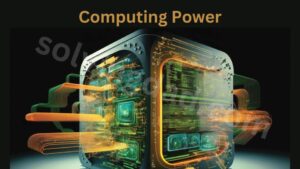
Computing power, often referred to as processing power or computational power, is a computer system’s or device’s capacity to carry out computations, process data, and carry out instructions with a specific rate of speed and efficiency. It is a way to gauge how quickly and efficiently a computer can carry out different tasks like running software programmes, manipulating data, and doing arithmetic computations.
The computing power of a computer system is influenced by several factors, including:
- Central Processing Unit (CPU): The CPU does the majority of the processing duties and is referred to as the “brain” of the computer. The number of processing cores, clock speed (measured in GHz), and the architecture and design of the CPU are all elements that affect the computing capacity of a CPU.
- GPU: Although they were first made for producing graphics, contemporary GPUs are also utilised for general-purpose parallel processing workloads. GPUs are used in applications like gaming, scientific simulations, and artificial intelligence because they are excellent at handling highly parallelizable computations.
- Random Access Memory (RAM): A computer’s capacity for RAM has an impact on how rapidly it can store and access data. The performance of the computer is enhanced by adding more RAM, which enables it to manage bigger datasets and run more applications concurrently.
- Storage: How quickly data is retrieved and stored depends on the type and speed of the storage, such as solid-state drives (SSDs) or hard disc drives (HDDs).
- Architecture and Instruction Set: The efficiency with which certain tasks are carried out can vary depending on the computer architecture and instruction set used. Some instruction sets, for instance, might be tailored for particular mathematical processes or multimedia applications.
- Parallel Processing: Using numerous processor cores or specialised hardware, such as GPUs, parallel processing refers to the capacity of a computer system to carry out several operations or calculations at once.
For scientific and mathematical tasks, processing power is often expressed in FLOPS (Floating-Point Operations Per Second) or MIPS (Million Instructions Per Second) but for general-purpose computing, it is expressed in tuples (Million Instructions Per Second). These measurements give a rough idea of a computer’s raw processing power and are frequently used in performance benchmarks.
In industries like scientific research, artificial intelligence, data analytics, and simulations, the requirement to handle more difficult tasks, run sophisticated software, and manage large datasets drives the demand for additional processing power. Computing power keeps growing as technology develops, allowing the creation of increasingly effective and potent computers and gadgets to support a variety of applications.
Also Read Tech for Beginners: A Guide to Understanding and Using Technology
10. 5G

5G, which stands for “fifth generation,” is the most recent version of wireless communication technology for mobile networks. In terms of data speed, capacity, latency, and connectivity, it provides a substantial improvement over earlier generations, such 4G/LTE. To meet the rising demand for data-intensive applications and the expanding number of connected devices in the present digital age, 5G is intended to offer faster and more dependable mobile internet connectivity.
Key features and characteristics of 5G technology include:
- Faster Data Rates: When compared to 4G/LTE, 5G offers far faster data rates. Theoretically, peak download speeds of up to several gigabits per second are possible, enabling lag-free streaming, quick downloads, and better internet performance in general.
- Low Latency: The amount of time it takes for data to move between devices and the network is referred to as latency. In order to support real-time interactions and applications like augmented reality, virtual reality, and gaming, 5G seeks to reduce latency to as little as a few milliseconds.
- Increased Network Capacity: 5G networks can accommodate a large number of connected devices in a restricted space. This scalability is necessary to support the increasing number of IoT devices and applications for smart cities.
- Improved Connectivity: 5G delivers better coverage and connectivity, especially in crowded cities and locations where network congestion is a typical problem in older generations.
- Spectrum Efficiency: To boost efficiency and enable greater utilisation of the limited spectrum resources, 5G makes use of cutting-edge radio technologies and spectrum management strategies.
- Network Slicing: With this feature, network administrators can build several virtual networks, each one tailored for a particular service or application, on top of a single physical infrastructure. Better customisation and effective resource management are made possible by network slicing.
The widespread adoption of 5G is expected to revolutionize various industries and enable innovative applications, including:
- Autonomous Vehicles: The low latency and high dependability of 5G are essential for facilitating communication between autonomous vehicles and infrastructure, ensuring more secure and effective transportation.
- Internet of Things (IoT): Thanks to 5G’s ability to support a huge number of connected devices, IoT applications in sectors including smart homes, smart cities, and industrial IoT are now more widespread.
- Telemedicine and Remote Surgery: The 5G network’s reduced latency can allow real-time telemedicine applications, making it possible for patients to get remote consultations and even help with difficult surgical procedures.
- Enhanced Mobile Experiences: 5G makes it possible for video streaming to happen more quickly, video calls to be of greater quality, and mobile games to run better.
- Smart Manufacturing: Real-time data sharing in smart factories is made possible by 5G, which boosts automation, effectiveness, and production.
The continued global rollout of 5G is anticipated to fundamentally alter how we connect, communicate, and utilise technology, opening up new opportunities and revolutionising a number of sectors.
Next 10 Technology Trends
11. Digital Trust
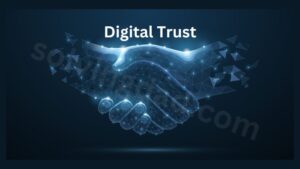
The term “digital trust” relates to people’s and organisations’ certainty and confidence in the dependability, security, and integrity of digital technologies, systems, and data. It serves as the cornerstone of safe and secure digital interactions where users can trust technology and digital platforms to safeguard their data, uphold their privacy, and provide the services and goods they expect.
Key elements of digital trust include:
- Security: The security measures used by digital platforms and services have a direct impact on consumer confidence in them. Users must feel confident that their information is secure from hacks, breaches, and unauthorised access. Building trust involves using effective cybersecurity procedures, secure authentication techniques, and strong encryption.
- Privacy: Users anticipate that their private information will be protected and kept private. Transparency in user data collection, use, and sharing is essential for building digital trust. Building trust requires explicit privacy policies and procedures for user permission.
- Reliability: Reliable digital platforms and services offer dependable performance. They should work as intended, be accessible when needed, and offer accurate and current information.
- Transparency: Transparency fosters trust in digital processes. Users tend to have higher faith in businesses and organisations that are transparent about their procedures, data usage policies, and security precautions.
- Data Integrity: Users have faith that the information they are given is true, unaffected, and unmanipulated. In industries like finance, healthcare, and critical infrastructure, ensuring data integrity is essential.
- User Experience: Enhancing user experience is crucial to developing online trust. Trust in digital services is increased via intuitive user interfaces, transparent communication, and smooth interactions.
Digital trust is essential in various contexts, including:
- E-commerce: Consumers must have confidence that online merchants will safeguard their payment information and fulfil product promises.
- Online banking: Customers anticipate their financial institutions to have safe systems and procedures in place to protect their money and personal information.
- Social media and communication: Confidence in the security and confidentiality of one’s conversations and personal information is essential for using social media platforms.
- Internet of Things (IoT): In an IoT setting, building digital trust is essential to guaranteeing the security and privacy of data gathered from linked devices.
- Telemedicine: Patients need to have faith that telemedicine platforms will allow them to communicate privately and securely with medical experts.
Building and upholding digital trust involves a dedication to user-centric, data-protective, and cybersecurity practises. Building digital trust is a competitive advantage for companies and organisations that promotes brand loyalty, customer happiness, and positive word-of-mouth.
12. Datafication
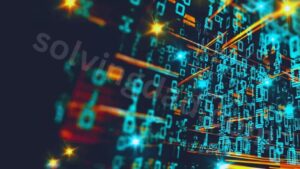
The term “datafication” describes the process of turning many facets of our lives and the outside world into digital data that can be gathered, saved, and analysed. It is the process of turning actions, attitudes, and occurrences into data points so they may be quantified, analysed, and used as a basis for decision-making. This phenomena has been made possible by the widespread use of digital technology, sensors, and connected devices, all of which produce massive volumes of data.
Key aspects of datafication include:
- Data Production: As digital technologies are used more and more, the amount of data produced has steadily increased. Online communications, social media posts, website visits, sensor readings, and financial transactions all generate data.
- Collection and Storage: The process of datafication entails gathering and storing enormous amounts of digital data from numerous sources. Data centres, cloud storage, and distributed databases are a few examples of the tools used to store and manage information.
- Data Analysis: The ability to analyse the gathered data to find patterns, trends, correlations, and insights is made possible by datafication. Techniques from data mining, machine learning, and statistics are frequently used in this investigation.
- Decision-making: Datafication insights have an impact on decision-making processes across a variety of industries, including business, healthcare, education, finance, and government.
Examples of Datafication:
- IoT stands for the Internet of Things. IoT devices have sensors that allow them to collect and send data from the physical world to the digital one. Various processes and services can be monitored and optimised using this data.
- Social media: Platforms for social media gather a lot of information about user interactions, preferences, and behaviours. In order to target adverts, personalise content, and understand user behaviour, this data is analysed.
- E-commerce and retail: To provide individualised recommendations and enhance the buying experience for customers, online shopping platforms gather information on customer preferences, purchase history, and browsing behaviour.
- Healthcare: Datafication in healthcare refers to the gathering and processing of patient information, electronic health records, and sensor readings to enhance medical research, diagnosis, and treatment.
- Smart Cities: Datafication in smart cities refers to the use of data from diverse sources including sensors, cameras, and mobile devices to optimise urban infrastructure and services like waste collection and traffic control.
Datafication has the potential to alter many different sectors and industries. It provides chances for improved decision-making, increased effectiveness, and superior services. But it also prompts questions about data security, privacy, and moral usage. Finding a balance between the advantages and difficulties that datafication provides becomes increasingly important for maximising its potential while defending individual rights and community interests.
13. Full Stack Development
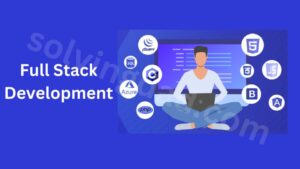
The term “full stack development” describes the process of creating software or online applications that include both the front-end (client-side) and back-end (server-side) elements of the programme. An individual who is a full-stack developer is one who is capable of working on all stages of the creation of a web application, from the user interface and user experience to the server-side logic and database administration.
Key components of Full Stack Development include:
- Front-end development: This entails working on the application’s client-side, which is where users actually interact. The user interface (UI) and user experience (UX) components are made by front-end developers using tools like HTML, CSS, and JavaScript. They also create interactive and responsive web sites using front-end frameworks like React, Angular, or Vue.js.
- Back-End Development: The server-side of an application, which manages data processing, database interactions, and business logic, is the focus of back-end development. The essential functionality of an application is built by back-end developers using server-side programming languages like Python, Ruby, Java, or Node.js. To store and retrieve data, they use databases (such as MySQL, PostgreSQL, and MongoDB), and they put APIs (Application Programming Interfaces) into use to allow communication between the front-end and back-end components.
- Database administration: To plan and implement the application’s data storage and retrieval processes, full stack developers must be knowledgeable in database administration. Writing queries, building and optimising database schemas, and ensuring data security all fall under this category.
- DevOps and Deployment: Full stack developers are frequently in charge of setting up and maintaining the programme on servers or cloud computing platforms. To make sure the application functions well in a production setting, they must be aware of DevOps practises and deployment technologies.
- Version Control: For full stack engineers to effectively work with other team members and handle code changes, knowledge of version control systems like Git is a necessity.
Full-stack developers are adaptable and competent to manage all phases of the development process. They can interact with experts in particular fields as a part of a development team or work on projects solo. Having full stack developers is advantageous since they can work on different aspects of a project, resulting in more simplified development procedures and quicker prototyping.
Although full stack engineers have a wide range of skills, it’s important to keep in mind that they might not possess the same depth of knowledge as specialised front-end or back-end developers. A development team may consist of a mix of full stack developers and specialists depending on the size and complexity of a project to provide the best outcomes.
14. Internet of Behaviours

The notion of the “Internet of Behaviours” (IoB) broadens the use of the “Internet of Things” (IoT) by emphasizing the gathering and analysis of data about human behaviours. IoB makes use of numerous digital technologies, such as sensors, IoT devices, data analytics, and artificial intelligence, to track and examine people’s behaviour in both physical and virtual settings.
To better understand and impact decision-making processes, enhance user experiences, and promote desired results, the Internet of Behaviours’ core goal is to obtain insights on both individual and collective behaviours. It entails monitoring and evaluating data from numerous sources, including wearable technology, social media interactions, location tracking, internet purchases, and other digital footprints.
Key aspects of the Internet of Behaviours include:
- Data Gathering: In order to build a complete picture of people’s behaviours, IoB relies on the ongoing collecting of data from numerous sources. Online behaviours, bodily movements, physiological readings, preferences, and interactions with digital systems can all be included in this data.
- Data Analysis: Advanced data analytics and artificial intelligence techniques are used to process and analyze the gathered data. In order to derive useful insights, machine learning algorithms find patterns, correlations, and trends in human behaviours.
- Personalization and Decision-Making: IoB offers personalized experiences and services based on the comprehension of unique behaviours. It can be used to make data-driven decisions, provide individualised recommendations, and streamline procedures.
- Business and Social Impact: The Internet of Things (IoB) has applications in a number of fields, including public safety, healthcare, education, and marketing. It can be applied to increase healthcare results, boost customer engagement, boost public service delivery, and more.
- Privacy and Ethical Issues: Because the IoB deals with sensitive information about people’s behaviours, privacy and ethical issues are brought up. The adoption of the Internet of Things must take into account data security, permission, and ethical data use.
Examples of Internet of Behaviours applications:
- Employee Monitoring: To increase productivity at work and employee well-being, businesses can utilise IoB to track interactions and behaviors among employees.
- Personal Health Monitoring: In order to provide individualized health recommendations, IoB can monitor a person’s health-related behaviors, such as physical activity, sleep patterns, and nutrition.
- Smart Cities: The Internet of Things (IoB) can be used in urban settings to collect information on citizen behaviours, traffic patterns, and public utility usage to improve municipal planning and service delivery.
- Retail and the customer experience: IoB can assist businesses in learning about consumer preferences and behaviour in order to offer specialised shopping experiences and marketing initiatives that are more precisely targeted.
- Behavior-based Authentication: IoB is a method for user authentication that adds an extra layer of protection by analysing user behaviour to spot potential security concerns.
The Internet of Behaviours highlights crucial issues with data privacy, consent, and possibly ethical ramifications. Finding a balance between using behavioral insights for beneficial outcomes and protecting people’s rights and privacy becomes more and more important as technology advances.
15. DevOps
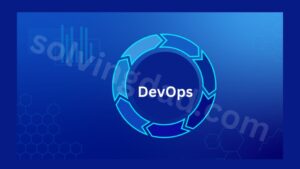
The goal of DevOps is to enhance teamwork and communication between IT operations (Ops) and software development (Dev) teams. DevOps is a set of practises and principles. In order to deliver software and IT services more effectively, dependably, and quickly, it places a strong emphasis on the integration of people, processes, and technology.
The main objectives of DevOps include:
- Continuous Integration (CI): To assure code quality and find problems early in the development cycle, developers often integrate their code changes into a shared repository. Automated build and test processes are then launched.
- Continuous Delivery (CD): After the required tests have been passed, code updates are automatically sent to production or staging environments, extending CI. The quick and dependable delivery of new features and upgrades is made possible via this method.
- Automation: DevOps places a strong emphasis on automating routine processes, including infrastructure provisioning, testing, and code deployment. Automation enables quicker development cycles, improves productivity, and reduces human error.
- Collaboration: Developers, testers, operations staff, and other stakeholders are encouraged to work together and assume shared responsibility through DevOps. Effective problem identification and solution are facilitated by close collaboration and communication.
- Monitoring and Feedback: To learn more about the functionality and user experience of infrastructure and applications, DevOps teams employ continuous monitoring and feedback loops. Teams can use monitoring to find problems early on and take proactive action.
Key practices and technologies associated with DevOps include:
- Version Control: To manage and track changes to the source code, teams utilise version control systems (such as Git).
- Tools for Continuous Integration and Delivery (CI/CD): Processes for build, testing, and deployment can be automated with the aid of tools like Jenkins, GitLab CI/CD, and Travis CI.
- Configuration management: Automated provisioning and management of infrastructure and application configuration are made possible by tools like Ansible, Puppet, or Chef.
- Containerization: Tools like Docker and Kubernetes make it easier to package, launch, and manage applications inside of portable, lightweight containers.
- Collaboration platforms: Programmes like Microsoft Teams and Slack enable team members to communicate and work together in real-time.
DevOps encourages a culture of continuous improvement, where teams use their mistakes and victories to enhance their procedures moving forward. DevOps enables businesses to produce software more quickly, increase software quality, and react swiftly to changing customer and market demands by removing silos between development and operations.
16. 3D Printing
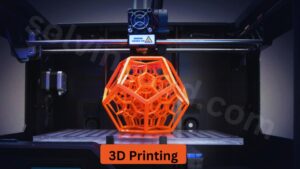
The method of 3D printing, sometimes referred to as additive manufacturing, involves adding material layer by layer to produce the finished thing. To reduce waste and enable intricate designs that would be challenging or impossible to accomplish using conventional techniques, 3D printing adds material just where it is needed, as opposed to typical subtractive manufacturing processes that involve cutting away material from a solid block.
Key components and characteristics of 3D printing include:
- Digital Design: The first step in the procedure is to create a 3D digital model of the item that will be produced. This model was created with the use of computer-aided design (CAD) software, or it was acquired through 3D scanning methods.
- Slicing: Slicing software is then used to cut the digital model into a series of thin, horizontal layers. At this point, the details of each layer, including its thickness and composition, are established.
- Printing: To create the physical thing, the 3D printer reads the model that has been cut into slices and begins to deposit material layer by layer. Plastics, metals, ceramics, resins, and even food products can all be printed on in some specialised printers.
- Layer-by-Layer Construction: The printer builds the finished 3D object gradually by fusing or solidifying the material as it goes through each layer.
- Post-Processing: Some printed goods could need additional post-processing operations once printing is finished, such as cleaning, polishing, or assembly.
3D printing has a wide range of applications across various industries, including:
- Rapid prototyping: 3D printing makes it possible to quickly and affordably prototype product designs, giving designers the chance to test and improve their concepts before moving to mass production.
- Manufacturing: Particularly in sectors like aerospace, automotive, and healthcare, 3D printing is occasionally utilized for small-scale or specialized production.
- Medical: Implants, prostheses, surgical models, and even organs can be printed using 3D technology and customised for individual patients.
- Education: The use of 3D printing in classrooms to teach students about design, engineering, and manufacturing ideas is growing.
- Art and design: 3D printing is a tool that designers and artists utilise to produce elaborate jewelry, sculptures, and other works of art.
Manufacturing procedures have been transformed by 3D printing, which enables more flexible design, shorter lead times, and individualised output. It is anticipated that technology will find even more varied and cutting-edge uses as materials and processes improve.
Also Read ROG ALLY RC71L Revolutionizing Gaming and Productivity
17. Predictive analytics
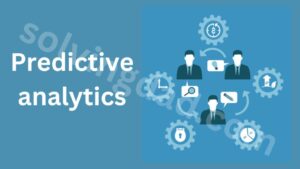
The use of historical data, statistical formulas, and machine learning to forecast future events or results is known as predictive analytics, an advanced data analytics technique. It entails the examination of historical data patterns and trends in order to find connections and correlations that are later applied to forecast upcoming trends, behaviors, or occurrences.
Key components and characteristics of predictive analytics include:
- Historical Data: A sizable volume of historical data pertinent to the target variable or event being forecasted is necessary for predictive analytics. Predictive models are trained using this data, and trends are found.
- Data preprocessing: The data is cleaned and made ready for analysis by preprocessing. This could entail managing missing values, eliminating outliers, and formatting the data appropriately.
- Feature Selection: To create prediction models, pertinent features or variables are chosen from the dataset. For reliable forecasts, the correct features must be chosen.
- Model Construction: Predictive models are constructed using a variety of statistical and machine learning algorithms using historical data. Regression analysis, decision trees, neural networks, and support vector machines are examples of common methodologies.
- Model Training: The predictive models are trained using historical data, allowing the algorithm to learn to recognise patterns and connections between the input variables and the target variable.
- Evaluation of the Trained Models: The accuracy and performance of the trained models are tested using validation data. Finding the best model to use for predictions is assisted by this step.
- Prediction: After being trained and validated, the predictive model can be used to forecast future occurrences or results based on fresh data.
Predictive analytics is widely used across various industries and applications, including:
- Business and Marketing: Predictive analytics is used to estimate customer behaviour, identify possible leads, optimise marketing campaigns, and enhance revenue forecasts.
- Finance: Predictive analytics aids in the identification of fraud, the evaluation of credit risk, and the forecasting of stock prices and market movements.
- Healthcare: Predictive analytics is used to anticipate patient readmission rates, pinpoint patients at risk for particular illnesses, and enhance treatment strategies.
- Manufacturing and Supply Chain: For manufacturing operations, predictive analytics may enhance demand forecasting, supply chain optimisation, and maintenance planning.
- Human Resources: Predictive analytics is used in human resources for workforce planning, performance evaluation, and employee turnover prediction.
Organisations are empowered to make data-driven decisions, foresee future trends, and reduce risks thanks to predictive analytics. It benefits institutions and companies.
18. Genomics

The study of genomes, or an organism’s whole set of DNA, is known as genomics. It includes the examination, sequencing, and interpretation of the genetic data found in the DNA of an individual or of a species. Understanding the genetic underpinnings of life and its different processes requires a thorough understanding of genomics, a subfield of molecular biology.
Key aspects and components of genomics include:
- DNA Sequencing: Adenine, thymine, cytosine, and guanine are the four nucleotides that make up an organism’s DNA, and DNA sequencing identifies the precise order in which they are present. With the development of DNA sequencing tools, it is now possible to analyse genomes quickly and affordably.
- Genome Assembly: Following the sequencing process, the raw data is put together and arranged to create the whole genome sequence, which involves identifying the genes, regulatory areas, and other functional components.
- Annotation of the genome: Annotation of the genome identifies and describes the many genes, non-coding regions, and other functional components that are present in the DNA sequence.
- Comparative genomics: This discipline compares the genomes of several species to clarify evolutionary links and pinpoint genetic similarities and differences.
- Functional Genomics: The goal of functional genomics is to comprehend how genes interact with one another inside an organism. The study of proteins using proteomics, transcriptomics, and other molecular techniques are all included.
- Personal genomics: Personal genomics is the study of a person’s genetic make-up to determine their propensity for contracting specific diseases, potential drug reactions, and ancestry details.
Genomics has numerous applications and impacts in various fields:
- Biomedical Research: In biomedical research, genomics is essential for understanding the genetic underpinnings of disease, locating genes linked to disease, and creating specialised treatments.
- Precision medicine: By examining a person’s DNA, medical professionals can better decide on individualised treatments and preventative measures.
- Agriculture: Crop breeding uses genomics to increase productivity, disease resistance, and other desirable features.
- Biology of conservation: Genomics aids in the study of critically endangered species and the development of conservation measures.
- Forensics: DNA profiling is used in forensic investigations to identify people and resolve criminal cases.
With improvements in sequencing methods, computational tools, and methods for data processing, the subject of genomics is fast developing. Genomic information continues to have a significant impact on many facets of human health, biology, and society as it becomes more available and more reasonably priced.
19. AI-as-a-Service

Artificial intelligence (AI) resources and capabilities are made available as on-demand services through the AI-as-a-Service (AIaaS) cloud computing architecture. This concept does away with the requirement for businesses to develop and manage own AI infrastructure by allowing users to access AI tools, platforms, and algorithms through the internet.
Key features of AI-as-a-Service include:
- Scalability: AIaaS platforms can adjust their resource allocation in response to customer demand. Organisations may acquire more computing power and AI capabilities as needed thanks to this flexibility without having to spend money on pricey hardware.
- Cost-Efficiency: AIaaS does not require initial investments in infrastructure for artificial intelligence or ongoing maintenance expenses. AI is more affordable for businesses of all sizes since consumers pay for the services they use on a subscription or pay-as-you-go basis.
- Accessibility: AIaaS makes AI technology available to a wider range of users, including startups, small companies, and people who might not have the resources or know-how to develop and manage AI systems on their own.
- Pre-Trained Models: AI as a Service (AIaaS) providers frequently supply pre-trained machine learning models and algorithms that users can utilise for their unique applications, such as natural language processing, computer vision, and predictive analytics.
- Customization: AIaaS provides consumers with the option to fine-tune and customise pre-built models to suit their unique use cases and data.
- Integration: By integrating AIaaS platforms with current applications and systems, businesses can add AI capabilities to their software products or services.
Common AIaaS offerings include:
- NLP APIs: With the help of these APIs, programmers can incorporate language comprehension and sentiment analysis features into their applications.
- APIs for image and video recognition: These APIs let programmers implement computer vision features including object identification and image classification.
- Platforms for machine learning: These platforms offer information and tools for developing, implementing, and administering machine learning models.
- Speech Recognition and Synthesis APIs: Applications can process and produce human voice using speech recognition and synthesis APIs.
Important cloud service providers, such as Amazon Web Services (AWS), Microsoft Azure, Google Cloud, and IBM Cloud, provide a variety of AIaaS solutions to meet a range of corporate demands.
AI-as-a-Service has democratised the adoption of AI, opening it out to a larger audience and hastening the incorporation of AI technologies into numerous sectors and applications. It enables businesses to utilise AI’s capabilities without having to worry about managing AI infrastructure, allowing them to concentrate on innovation and value development.
20. Drones and unmanned aerial vehicles (UAVs)
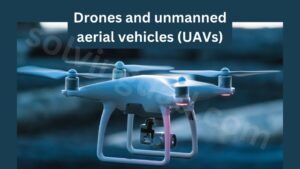
Unmanned aerial vehicles (UAVs) and drones are types of aircraft that fly autonomously. They are also frequently known as remotely piloted aircraft systems (RPAS) or unmanned aircraft systems (UAS). These vehicles can be remotely operated by a person or they can drive themselves using sensors and pre-programmed instructions.
Key characteristics of drones and UAVs:
- No need for a human pilot: Drones and UAVs operate without a pilot, unlike conventional aircraft. Instead, they either run independently with the aid of sophisticated software or are controlled remotely from the ground by a remote operator.
- Versatility: Drones are available in a variety of shapes and sizes, from small quadcopters and fixed-wing aircraft to big, military-grade reconnaissance or combat drones. Due to their adaptability, they can be utilised for a variety of purposes.
- Use in both the military and the civilian world: Drones have uses in both worlds. They are employed for a variety of functions in the civilian sector, including aerial photography, videography, mapping, surveillance, agriculture, animal monitoring, search and rescue operations, and package delivery. Drones are used in the military for target acquisition, surveillance, reconnaissance, intelligence gathering, and occasionally offensive actions.
- Remote control and autonomous capabilities: Using specialised controllers or software programmes, a human operator may remotely control the majority of drones to perform autonomous tasks. Additionally, some UAVs come with cutting-edge sensors and artificial intelligence to enable autonomous flight and decision-making, minimising the demand for ongoing human involvement.
- Benefits and drawbacks: Drones have a number of advantages over regular aircraft, including the ability to visit remote or hazardous places, cost effectiveness, and reduced risk to human life during some tasks. However, they also pose difficulties, such as the possibility of unauthorised usage, safety problems, regulatory complications, and privacy concerns.
- Growing industry: A large number of businesses are now designing and producing drones for a variety of uses, thanks to the drone industry’s recent tremendous rise. Governmental organisations and regulatory authorities are also attempting to create standards and regulations for responsible and safe drone use.
Overall, drones and UAVs have developed into crucial tools for many different businesses, and as technology and laws advance, it is anticipated that their use will only increase.
conclusion
Industry altering and user experience-improving technologies include AI, ML, edge computing, RPA, quantum computing, VR, AR, and blockchain. IoT and 5G promote efficiency and connectivity. Predictive analytics supports data-driven decision-making while digital trust promotes reliable technology utilisation. Medicine, agriculture, and conservation are all impacted by genomics. Transport is being revolutionised by autonomous cars. Responsible use of these developments ensures a promising and creative technological future.
Which technology is best in 2023?
Artificial Intelligence (AI) and Machine Learning (ML) is the best technology of 2023.
How are VR and AR changing experiences?
VR and AR are revolutionizing entertainment, education, and training by creating immersive and interactive experiences.
How does IoT impact our daily lives?
IoT connects devices and enables smart ecosystems, leading to increased efficiency and convenience in everyday life.
How does predictive analytics help decision-making?
Predictive analytics analyzes patterns and trends in data to make informed decisions and predictions.
How is AI transforming industries?
AI is automating tasks, optimizing processes, and making data-driven decisions across industries like healthcare, finance, and manufacturing.
